Seal of Massachusetts
The Great Seal of the Commonwealth of Massachusetts contains the coat of arms of Massachusetts. The coat of arms is encircled by the Latin text "Sigillum Reipublicæ Massachusettensis" (literally, The Seal of the Republic of Massachusetts). The Massachusetts Constitution designates the form of government a "commonwealth," for which Respublica is the correct Latin term. The Seal uses as its central element the Coat of Arms of Massachusetts. An official emblem of the State, the Coat of Arms was adopted by the Legislature in 1775, and then reaffirmed by Governor John Hancock and his Council on December 13, 1780. The present rendition of the seal was drawn by resident-artist Edmund H. Garrett, and was adopted by the state in 1900.[2] While the inscription around the seal is officially in Latin, a variant with "Commonwealth of Massachusetts" in English is also sometimes used.[3]
History
The seal was adopted by the Provincial Congress on December 13, 1780. The shield depicts an "Indian" with bow and arrow; the arrow is pointed downward, signifying peace. A silver star with five points appears next to the figure's head, although this is represented as white on the flag. A blue ribbon (blue, signifying the Blue Hills of Quincy, Canton and Milton) surrounds the shield, bearing the state motto "Ense petit placidam sub libertate quietem" This comes from the Book of Mottoes in the Royal Danish Library in Copenhagen, Denmark; written about 1659 by Algernon Sydney, English soldier and politician. It was adopted in 1775 by the Provincial Congress and the literal translation is, "With a sword, she seeks quiet peace under liberty." Although the looser English translation more commonly used is, "By the sword we seek peace, but peace only under liberty." Above the shield is the state military crest: a bent arm holding a broadsword aloft. The sword has its blade up, to remind that it was through the American Revolution that independence was won.
There have been a number of Seals of Massachusetts throughout history. The first seal of Massachusetts Bay Colony showed a nude American Indian with a bush covering his groin. Like the current seal, he held in his hand an arrow pointed down. A scroll came out over his mouth with the words "Come over and help us", emphasizing the missionary and commercial intentions of the original colonists. This legend coming from the Indian's mouth may originate with Acts 16:9: "And a vision appeared to Paul in the night; There stood a man of Macedonia, and prayed him, saying, Come over into Macedonia, and help us." (Authorized Version).[4] This seal was used until 1686, shortly after the charter was annulled, and again from 1689-1692.
In 1775 the Revolutionary seal appeared, depicting a minuteman with a sword in his right hand and the magna carta in his left; following the Revolutionary War, the sword would later be incorporated into the crest of the traditional coat of arms. The Revolutionary seal would also mark the first time the Latin motto used by the state today appeared on a state seal, and meant that the colony no longer recognized the authority of the Royal Governor General Thomas Gage. The source is attributed to the letter written by a father of an English soldier and politician Algernon Sidney: "It is said that the University of Copenhagen brought their album unto you, desiring you to write something therein; and that you did scribere in albo these words: 'Manus haec inimica tyrannis ense petit placidam sub libertate quietem'". (Translated, this means "This hand of mine, which is hostile to tyrants, seeks by the sword quiet peace under liberty.") The last words were then written in Sidney's "Book of Mottoes", particularly favored by some in the American colonies. Metrically, the motto is dactylic hexameter.
A stained glass window at the top of the Grand Staircase at the State House shows all the seals used in Massachusetts, including the royal seals of the Governors during colonial days.
Government Seals of Massachusetts
 Seal of the Governor of Massachusetts
Seal of the Governor of Massachusetts Seal of the Massachusetts House of Representatives
Seal of the Massachusetts House of Representatives Seal of the Massachusetts Senate
Seal of the Massachusetts Senate.svg.png) Alternative seal of the Massachusetts Senate
Alternative seal of the Massachusetts Senate Seal of the Massachusetts State Police
Seal of the Massachusetts State Police
Historical Seals
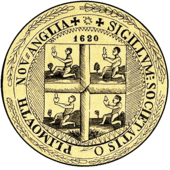 Seal of the Plymouth Colony
Seal of the Plymouth Colony Seal of the Massachusetts Bay Colony
Seal of the Massachusetts Bay Colony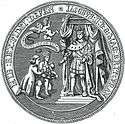 Seal of the Dominion of New England
Seal of the Dominion of New England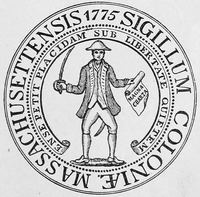 Seal used by the Massachusetts Provincial Congress
Seal used by the Massachusetts Provincial Congress
See also
References
- 950 CMR 34.00: Commonwealth of Massachusetts Flags, Arms, and Seal Specifications
- Garrett, E. H. (1901). "The Coat of Arms and Great Seal of Massachusetts". The New England Magazine. Boston: Warren F. Kellogg. XXIII (6): 623–635.
- House of Representatives Proclamation
- Stockbridge Mohican History, 'The Seal of the Massachusetts Bay Colony: "Come Over and Help Us' "The Seal of the Massachusetts Bay Colony: "Come Over and Help Us"". Archived from the original on 2015-01-07. Retrieved 2015-09-19. accessed 19 September 2015
External links
- The History of the Arms and Great Seal of the Commonwealth of Massachusetts
- Arms of Massachusetts, American Heraldry Society
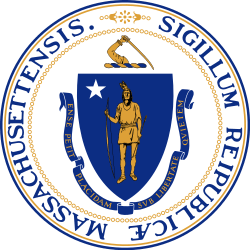
.svg.png)
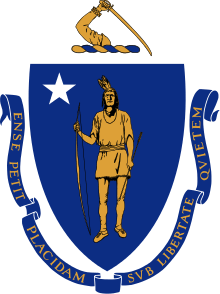

.jpg)
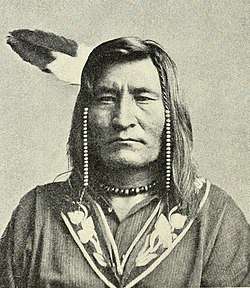

.svg.png)